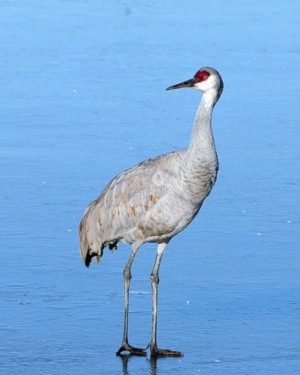The oldest living bird species just happens to live in B.C.
Wing fossils of the sandhill crane found in Nebraska date back nine million years to the Miocene era, and they certainly still have a prehistoric look about them.
The Comox Valley area is not a usual pit stop for migratory cranes, but each year, they pass overhead in flocks. They are known to land in the Nanaimo area, but the largest flocks can be found in Delta at the Reifel Bird Sanctuary.
In 10 years at MARS, I have encountered only one crane that was very memorable. Last week, a single bird was reported grounded in Merville.
It appeared that the bird was left behind when the flock continued its southern migration; it sought out company at a Muscovy duck farm.
The ducks were in an enclosure, and the crane was pacing along the fence line, maybe hoping to join them. Having determined that the crane could fly and was foraging and not in any distress, the decision was made to try and catch and relocate the crane with a flock.
When I heard about the crane and its relocation, I immediately thought of Mike Yip, who is always out and about photographing wildlife. I had seen recent sandhill crane photos on his website.
Yip confirmed the sandhill cranes were still at the Reifel Bird Sanctuary in Delta and offered to transport the crane once it was caught. Capturing the bird was very easy with the help of a new remotely triggered “bow net” (donated by the Hornby Eagles Project Society).
The capture of the bird created quite a stir with biologists from the Canadian Wildlife Service and the Hemmera Corporation, which were informed that the bird was coming to the Reifel Sanctuary. They conducted blood and feather samples to help determine the sub species, which identified it as a lesser sandhill crane.
The bird was then banded with a federal band and also bright orange and yellow bands on the other leg in hopes that birders will be alerted to record its location. It had been hoped to mount a satellite tracking transmitter on the crane, but permits could not be obtained in time. Data collected will be invaluable for further understanding, distribution, migration and taxonomy of the cranes.
So far, only one other B.C. bird and seven from Alaska have been banded. If you wish to find out more, please consider a trip to Delta and experience the truly amazing phenomenon of migration.
To report injured wildlife or for advice, please call 1-800-304-9968. To follow the latest patients at M.A.R.S, please go to www.wingtips.org.
Sandy Fairfield is the educational co-ordinator for the Mountainaire Avian Rescue Society (MARS). The MARS column appears every second Friday.
